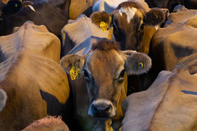Animals can be tattooed or branded with a hot or frozen iron. Some farmers also acquire special approval to use other means of branding, with especially microchips being used for high-value animals.

Concern has been raised about the current animal identification system, with draft legislation printed in 2018 – Draft Document For A Livestock Identification And Traceability System South Africa – promoting the use of plastic ear tags that are primary identifiers for cattle, sheep, goats, pigs and aquaculture.
The beauty is that ear tags have become highly sophisticated over the years, with it now being equipped with radio frequency identification, which eases on-farm record-keeping.
Hot Iron Branding
The farmer’s guide of the National Stock Theft Prevention Forum, suggests that it is easier to use a separate iron for each character of the identification mark. The sequence of the mark and the heat can be tested on a piece of wood to ensure it is right before it is used on the animal.
It is best to have more than one helper and to brand the animals in a crushing pen. An immobiliser or knee-halter should be used to prevent the animal from kicking the handler.
The iron will have an ash grey-colour when it is ready to be used and then placed, not pressed, against the animal’s skin for three slow counts. Ice or cold water can be applied to cool the wound. The guide specifically warns farmers not to apply dung or wipe the wound with a cloth, as this may lead to infections.
Freeze Branding
Freeze branding is considered more humane than hot iron branding, but it is not always successful and involves expensive equipment. The animal should be prevented from kicking you with an immobiliser or knee-halter and you should preferably have someone to help you.
The hair should be shaved off on the spot to be branded. The iron, which has to be stronger than that used for hot iron branding, is cooled down in liquid nitrogen or dry ice with methylated spirits, until the iron stops giving off bubbles.
Excess nitrogen or spirits should be shaken off before the animal is branded, to prevent flow-off. The farmer’s guide to the prevention and handling of stock theft advises farmers to press hard for 20 to 25 second on animals of six to eight month, for 25 to 30 seconds for animals of nine to eighteen months and 30 to 35 seconds for animals over 18 months.